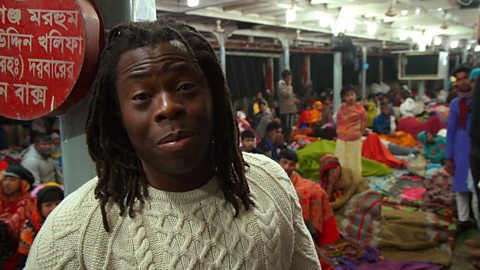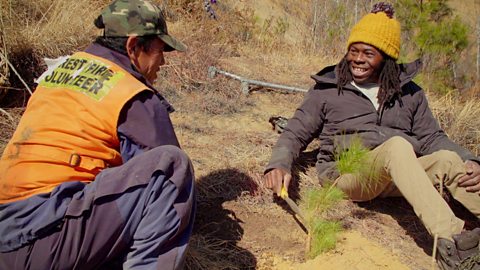Ade Adepitan visits a village in Bangladesh which is slowly being flooded by rising water levels.
ADE: Hi, my nameβs Ade Adepitan and Iβm in Bangladesh which is one of the countries thatβs been hardest hit by climate change. Iβve come to see how a combination of rising sea levels and extreme weather events is affecting life here.
TANJIL: For last uh, ten fifteen years I cross this river at least once every year and the land was definitely say up to there.
ADE: So it would go from all the way over there towards those trees?
TANJIL: Yes.
ADE: It feels like thereβs water everywhere now. But just a few years this area was covered in fertile farmland.
So youβve actually physically watched this place shrink.
TANJIL: In last ten years things are changing very rapidly. *[SPEAKS BANGLADESHI]
ADE: This is gonna be fun, trying to get up this mud bank. Shoulder.
TANJIL: [AS THEY HELP ADE UP A MUD BANK] Try to be on us, so youβre not stepping too much.
ADE: Yeah, Iβm doing that, stay light foot.
Four thousand people used to live in this village, now just a couple of hundred remain, struggling to survive on this tiny strip of land.
Oh my, look at this! Wow!
TANJIL: Well, this is, this is actually newly built, you can see new bamboo because the road has just broke from here.
ADE: All of this was connected.
TANJIL: Oh, yeah, yeah.
ADE: Over time the water has weakened the land here and bit by bit itβs literally been washed away.
Iβve come to meet Dipok Mondo, one of the few people still living in the village.
TANJIL SUBTITLED: [SPEAKS BANGLADESHI] How are you?
DIPOK SUBTITLED: [SPEAKS BANGLADESHI] I'm well.
ADE: Ah good, nice to meet you, my nameβs Ade.
DIPOK SUBTITLED: [SPEAKS BANGLADESHI] I am Dipok.
ADE: Dipok. Dipok, good to meet you! [TO A CHILD] Yeah, give me a high five man! There you go! Dipok, how long have you lived here for?
DIPOK SUBTITLED: [SPEAKS BANGLADESHI] We moved to this house four years ago. This is where we're staying for the moment. I was born here in this village. I had six acres of land and none of it is left. So now we're living on the very last bit of it. I can show you where my old house was.
ADE: Ok, thank you.
DIPOK SUBTITLED: [SPEAKS BANGLADESHI] This is where my first house was. Now the water has taken it, it's in the middle of the river.
ADE: So your house is now below all of this water?
DIPOK SUBTITLED: [SPEAKS BANGLADESHI] That's right.
ADE: Itβs mind boggling.
DIPOK SUBTITLED: [SPEAKS BANGLADESHI] We used to have land and we lived off the rice we grew. We had ponds full of fish and barns full of cows. There's nothing left, the water took everything away.
ADE: Iβm sorry. Iβm sorry.
DIPOK SUBTITLED: [SPEAKS BANGLADESHI] It breaks my heart.
ADE: Since his house and his six acres of land went under, Dipok has had to do whatever he can to feed his family.
How does the fishing compare to your old life as a farmer?
DIPOK SUBTITLED: [SPEAKS BANGLADESHI] It isn't a great living. On some tides we catch crabs, but on some we don't. Farming rice was a much better way of life. We're struggling just to survive. It's a terrible feeling. It's done - we have to turn.
TANJIL: Oh, ok.
ADE: Ok. So weβre turning and we go back and checkβ¦?
TANJIL: Yes.
ADE: Oh. So maybe we caught some crabs, maybe.
DIPOK SUBTITLED: [SPEAKS BANGLADESHI] Slowly, slowly.
ADE: Oh, we might have something. We might have something. Hold on.
[PULLING IN THE FISHING LINE]
TANJIL: Oh, itβs gone.
ADE: Oh no!
DIPOK SUBTITLED: [SPEAKS BANGLADESHI] The crab took the bait and escaped.
ADE: Looks like weβve come to the end of the line.
DIPOK SUBTITLED: [SPEAKS BANGLADESHI] Got one!
ADE: [CRAB PULLED FROM THE WATER] Yes! Well done. Well done. Oh look at that.
DIPOK SUBTITLED: [SPEAKS BANGLADESHI] It's a female crab, a big one.
ADE: Yeah. Well done.
One crab didnβt seem like enough to feed a family. It felt like life here was hanging by a thread. Like the village was one storm away from disappearing completely.
Video summary
Ade Adepitan travels to Bangladesh to find out how a combination of rising sea levels and extreme weather events are affecting life.
He meets Dipok Mondal, one of the few people still living in his village. Once, 4000 people lived there, but now there are just a couple of hundred left, on a tiny strip of land. Over time the water has weakened the land and bit by bit itβs literally been washed away. Dipok now lives on the very last patch of what was once six acres of land.
This clip is taken from the ΒιΆΉΤΌΕΔ Two series, Climate change: Ade on the frontline.
Teacher Notes
Before watching the film
If you have already watched the other clips in this series concerning climate refugees in Dhaka and melting glaciers in Bhutan, it would be helpful to recap these film clips, identify Bangladesh on a map and discuss what students already know and think about the country and particularly the issues it faces through climate change. The first clip revealed that 1000 people a day were moving from low-lying areas of the country to the capital city of Dhaka.
This film shows an example of the conditions that are putting people under stress and causing some to move. You might ask students to imagine and describe what they expect to see.
During the film
You may wish to stop at relevant points during this short film to pose questions and check understanding or wait until the end. Useful questions might include:
- How many people lived here and how many remain? (4000 and now 200)
- How much land did Dipok have when he started farming? (six acres)
- What kind of farming did Dipok used to do and what does he do now?
You could discuss how he once had a barn full of cows and fertile land where he grew rice and had a pond full of fish. Now he survives fishing for mainly crabs β as do other people who live here.
- What is the effect on the ecosystem if many people are relying on one food source?
- What are the factors causing land loss here?
You could then discuss the combination of factors that include increased extreme weather conditions, such as cyclones and heavy monsoon rains; melt water from the Himalayas, storm surges causing water to erode already fragile riverbanks, the existing problem of low-lying land and encroaching sea level rise.
- How would you feel to be Dipok?
- What options do you have?
Following on from the film
Where exactly is this place in Bangladesh? Watch the film again and ask students to gather clues so they can locate it on a map. At one point, Dipok explains that although he has only lived in his current house for four years he was "β¦ born here in Kalabogi". Finding this place on the map and looking at it in both map and aerial view, shows how little land remains here in relation to surrounding water.
You could discuss with students what options there are to combat flooding and the usefulness of different approaches for this location and situation. You could identify short term solutions to flooding and identify these, such as government food aid and water purification tablets, repairing river embankments and giving farmers new seed. How practical and useful do students think these short-term solutions are?
Students could identify longer term solutions such as building river embankments, flood retreat areas and afforestation, and evaluate those that might be effective in this situation. As a lower income country Bangladesh does not have the money to pay for flood defences. Do students think it is fair that poorer countries such as Bangladesh are feeling the effects of climate change far worse than some richer countries who may be contributing more to climate change through their lifestyle emissions?
You might ask students to research and make recommendations for a plan of action that would be sustainable here for people, environment, and the economy. What global solutions are needed to mitigate the effects of climate change?
This short film is suitable for teaching KS3 and KS4 students.
It can be used alongside the other Ade Adepitan films about climate change or watched on its own but it links well with the other clips about climate refugees travelling to Dhaka, tree planting and melting glaciers in Bhutan. All the films build on studentsβ understanding of climate change issues and enable them to make global connections.
This film supports the KS3 geography curriculum by investigating our changing climate, flooding and its impacts, with opportunities to develop a case study in Bangladesh.
At KS4, the film supports understanding the effects of climate change, natural hazards, coastal and river flooding and land management.
This clip could be used to support the delivery of geography to KS3 and KS4 students. Specifically, this topic appears in OCR, Edexcel, AQA, WJEC KS4/GCSE in England and Wales, CCEA GCSE in Northern Ireland and SQA National 4/5 in Scotland.
Climate refugees in Dhaka, Bangladesh. video
Ade Adepitan meets climate refugees in Bangladesh, who have been forced by rising sea levels to seek a new life in their capital city of Dhaka.

Melting glaciers in Bhutan. video
Ade Adepitan visits Bhutan to see the effects of rising temperatures on the glaciers there, and the danger this poses to the communities further down the valleys.

Planting trees in Bhutan. video
Ade Adepitan meets Sonam Phuntsho, who has planted more than one hundred thousand trees in Bhutan. Planting trees is one of the cheapest and most effective ways we have of tackling climate change.
